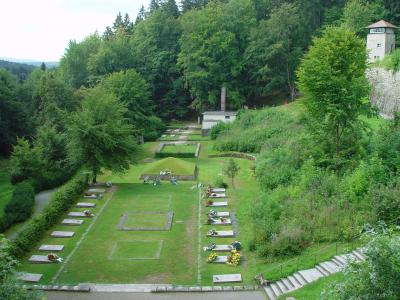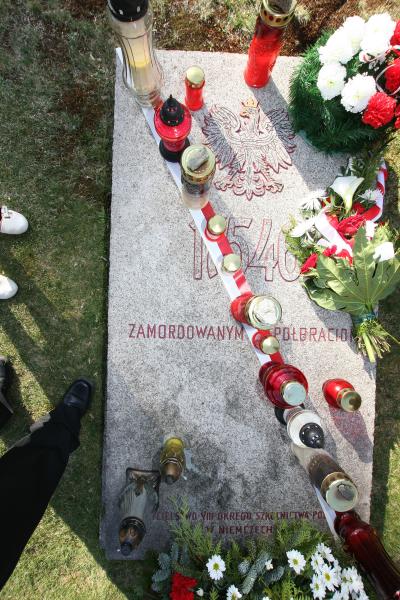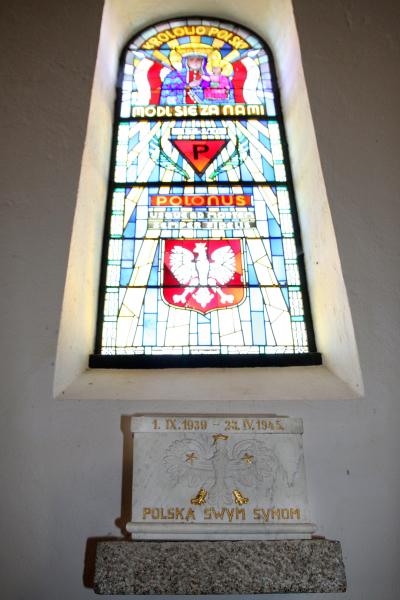KZ Flossenbürg
The first mass executions under the sentences issued by the Gestapo and special courts were carried out in September 1941. On the basis of the Kommissarbefehl (order on commissioners), issued on the 6th of June 1941, the first group of 41 Russian prisoners of war, political officers of the Red Army, was shot. The total estimated number of killed people is over 1,000. The next victims of death sentences were Polish prisoners of war and members of the resistance in Poland and other countries. The Nacht und Nebel (Night and Fog) action led to the arrest and murder of hundreds of Dutch, Belgians and French. The last action of the special courts in KZ Flossenbürg was the murder on the 9th of April 1945 of seven German opponents of the Nazi regime, including Father Dietrich Bonhoeffer and Admiral Wilhelm Canaris. SS members were involved in at least 2,500 executions and other kinds of murders (hanging, injection of poison). Only a few have been brought to justice for this.
Between 1938 and April 1945, Flossenbürg concentration camp had about 100,000 prisoners - 84,000 men and 16,000 women, including 31,400 Polish citizens. The number of 30,000 people from 22 countries deceased of exhausting labour, disease and epidemics, executions and death marches are only the documented cases. On the 23rd of April 1945, the American army liberated the camp. The soldiers found 1,526 seriously ill and dying prisoners in the camp. Already in mid-March 1945, 40,000 prisoners were sent southward in evacuation death marches, where at least 7,000 were murdered. The last evacuation columns were liberated on the 8th of May. Those who died already after the war because of exhaustion and various diseases should increase the number of victims. The victims included 41 Home Army soldiers, participants of the Warsaw Uprising, who were sent to the camp together with thousands of Warsaw inhabitants.
The Flossenbürg Concentration Camp Memorial Site covers the entire area of the former camp. There is still the steep road that the prisoners would walk every day on their way to work in the quarry; the foundations and the front wall of the barrack remained - today there is an exhibition there, documenting the crimes committed in the camp. Three stone watchtowers have also survived; next to one of them, there is a path leading to the crematorium, which has been preserved in its original state, with the transport ramp and the furnace in which the bodies of the murdered prisoners were burned. The road goes on to the so-called valley of death - the place of execution and the place where the ashes are deposited, located in several low pyramids covered with soil.
On the 3rd of May 1945, by order of the American occupation authorities and with the participation of all the German inhabitants of Flossenbürg, 18 prisoners who died after the liberation were buried in the centre of the town. By June 1946, over 100 more former prisoners were interred at this cemetery. The Poles who were still in the Displaced Persons' camp made a plan of a monument and a war cemetery in the town. On the 27th of October 1946, the graves and the newly-erected monument with an inscription in Latin "Consortes" (comrades) were solemnly consecrated.
In 1957, a cemetery was established within the former camp, where 5,000 victims of KZ Flossenbürg sub-camps and of evacuation marches were buried in individual, mostly nameless graves. On the wall near the chapel, there is a granite slab with an inscription in Latin, which has been supplemented in German in recent years:
In the place where representatives of 22 nationalities died, a chapel of "Jesus Imprisoned" was built on the initiative of former Polish and German concentration camp prisoners. This was decided during a joint meeting on 26.7.1946. In this chapel, instead of hatred and revenge - love and understanding between nations should be preached.
[translated from Polish]
The names listed below are a supplement or correction to the list of participants of the Warsaw Uprising known by their first name and surname:
BUJAK FRANCISZEK Rifleman, a.k.a. "Bohater", "Cichy"
* 1.4.1903 Zosin
† 23.10.1944 KZ Flossenbürg–Leitmeritz Czech Republic
GALERCZYK JÓZEF Rifleman, a.k.a. "Legun"
* 2.3.1894 Przyluski
† 23.10.1944 KZ Flossenbürg–Theresienstadt Czech Republic
KOMSTA TADEUSZ (Komota on the list) a.k.a. "Młot"
* 24.3.1922 Płock (1921 on the list)
† 8.3.1945 main camp
KORNEĆ STEFAN Rifleman, a.k.a. "Żeglarz"
* 13.11.1921 Warsaw
† 9.2.1945 KZ Flossenbürg–Leitmeritz Czech Republic
MAZUR EDWARD
* 7.6.1924 Warsaw
† 22.12.1944 KZ Flossenbürg–Leitmeritz Czech Republic
PYZA-PUZIŃSKI ZYGMUNT (only Pyza on the list) Rifleman, a.k.a. "Żbik"
* 9.1.1924
† 9.2.1945 KZ Flossenbürg–Leitmeritz Czech Republic
Rohrenschef/Röhrenschef Jan Lieutenant, a.k.a. "Rojewski"
* 6.5.1900 Tarnów
† 12.12.1944 KZ Flossenbürg–Leitmeritz Czech Republic
SOKOŁOWSKI ANTONI Lance Corporal Rifles
† 3.5.1945 after the liberation in KZ Flossenbürg
Tepicyn Igor (Tepizin on the list)
* 29.5.1917
† 11.4.1945 KZ Flossenbürg–Ansbach


